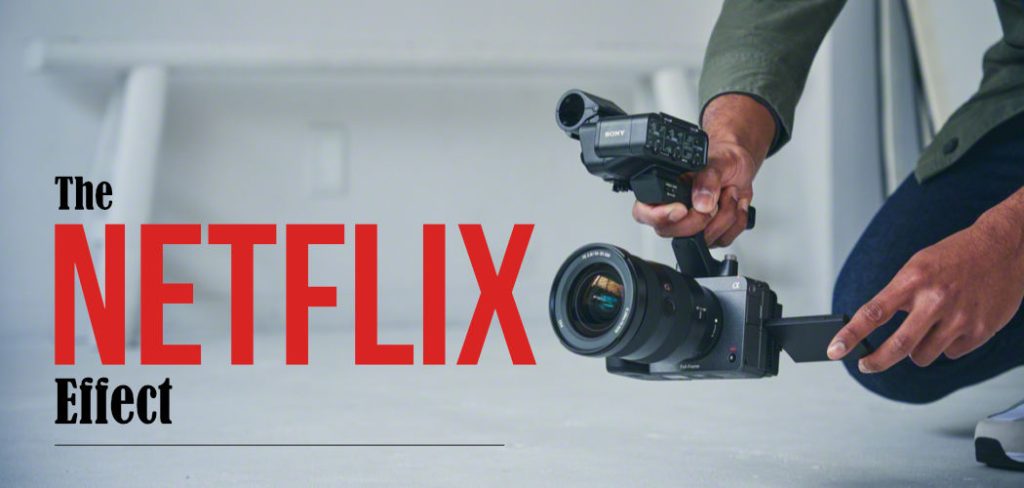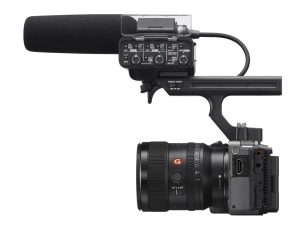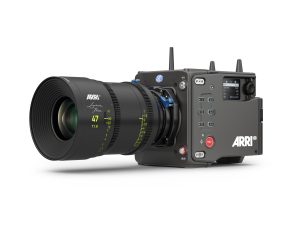
The Netflix Effect, as I call it, means you can now shoot a series, or a stand-alone feature for the streaming service, on a camera that costs less than £2,000 ($2,080 USD or 2,065 €) – cinema tech is at the top of its game.
Sony’s FX3 (pictured above and below), became the latest acquisition tool to be added to the Netflix approved list, at the time of the writing of this article. At £4,000 ($3,898 or 4,678€), the FX3 might not be the least expensive camera on the approved list but it is arguably one of the most fully featured for the money.
Netflix also has a non-approved list which, at the time of writing, included even cheaper production tools, in the form of the iPhone 12 and the GoPro Hero 9. Netflix makes it clear that the iPhone, the GoPro and others on the non-approved list should not be used as a primary camera but as one to acquire speciality shots – for example, a few seconds of a car chase, a drone image or a POV (point of view) shot.

The FX3 is a testament to how far camera technology has come and how affordable ‘approved’ cameras are beoming. Gaining Netflix approval is not that easy. The streaming service says that, besides resolution, it tests cameras for their dynamic range, colour reproduction, noise performance, sensor readout speed, compression, chroma subsampling and bit depth, among other attributes. To pass those tests was a huge achievement for the Panasonic BGH1, the cheapest camera on the Netflix approved list. It costs just £1,799.
Future TV
What does using a £4,000 camera, or even one costing half that, mean for the future of feature film or episodic steaming television?
- It is likely to mean a lower barrier to entry for production companies hoping to sell to Netflix.
- Firms using lower cost acquisition tools will likely have a higher profit margin, assuming Netflix does not decide to pay less for something that seemingly costs less to produce.
- Netflix’s camera and production best practice guidelines might be followed by other streaming services producing original content.
- High end productions will have even higher end crash cams.
Not the only tester in town
Netflix’s list of approved cameras and best practice is relatively up-to-date – the FX3, for example, was put on the approved list in August 2022. The European Broadcasting Union (EBU), also has a list of cameras that it has tested. The issue here is that detailed reports by Alan Roberts, a former BBC research engineer and consultant to the EBU, appear to have stopped in 2018, with the Panasonic GH5S seemingly the last camera body to be scrutinised. What does this mean? Is the EBU unable to maintain testing, given the barrage of new camera releases?
Image quality
The quality of images from cameras has been increasing, as the battle at the cheaper end of the market continues with smartphones, which are becoming more capable image acquisition tools with each iteration.
I have been in the media long enough to remember Revenge of the Great Camera Shootout 2012 (spoiler: skip to 13 minutes 42 seconds into the video to find out which image was made by which device). Directors of Photography in cinemas around the world were asked to choose which image(s) they liked, produced by nine cameras. One of them was an iPhone 4S and another was the Arri Alexa. To me, the whole exercise showed how far the camera technology in a smartphone had come and also how good almost any camera can look in the hands of an experienced director of photography.
Camera makers up their high end game
The Netflix Effect has, in my opinion, also had a bearing at the other end of the price spectrum, on high end cameras. For years, one of the most used and loved image creators for cinema, TV broadcast and streaming services has been the Arri Alexa Classic. Remember The Avengers, Skyfall and 21 Jump Street? They were all shot with the Alexa Classic. Its images still look fantastic in 2022 but with a native resolution topping out just above full HD at 2K (2048 x 1152), its presence as a leading image acquisition tool was beginning to look dated. It no longer met the basic requirements for Netflix original productions in a 4K world.

Arri has been working hard to bring a worthy successor to the Alexa Classic to market. On the last day of May 2022, Arri announced its new beast, the Alexa 35, a 4K native resolution sensor at up to 120 frames per second, better colour science and a show-stopping 17 stops of dynamic range.
High end features in low cost cameras
2022 also saw Sony start to ship its new flagship, the Venice 2, a full-frame digital cinema camera with a choice of 8K and 6K sensors, up to 16 stops of latitude and frame rates of up to 120fps. Remember, the original Venice was responsible for such classics as Bridgerton Seasons 1 & 2, Dahmer and the Black Panther: Wakanda Forever. So, here we are. Full circle. From one of the cheapest cinema cameras approved by Netflix to one of the most expensive, Sony has been prepared to do what many other camera manufacturers have not (with the major exception of Panasonic). It has used its know-how to bring us a £4,000 camera and one costing at least £58,000 (body only).
Sony has dared to include S-Cinetone with the FX3, based on Venice’s popular cinematic film like colour, creating agreeable skin tones without heavy post production work from a colourist. Sony has also put S-Log3 into the FX3, allowing “for better reproduction of gradation characteristics in shadows and the mid-tone range” with “characteristics closer to those of scanned film.” It’s the same gamma curve found in the Venice. Many other camera manufacturers might not have gone as far as putting identical technology in both their flagship camera and their least expensive ‘cinema’ camera. Can you imagine a £4,000 ‘Baby Alexa?’
RED seems to be the only other major manufacturer to be shipping a new high end cinema camera in 2022.
Content remains king
The point here is that I believe that Netflix and its standards have helped to drive up the quality of moving image acquisition equipment, giving us technically better movies and series however, content will always remain king. Going back to Revenge of the Great Camera Shootout, if top directors of photography could not tell the difference between footage acquired with an iPhone 4S and the same footage shot on cinema-grade cameras, does it really matter? It is the story that we remember after coming out of a cinema, not the colour science or the acquisition gear.
And here, I think that a £4,000 camera capable of holding its own in good company on the Netflix list, could well open doors to new filmmakers. Granted, it is not only a camera that draws us in to a cinematographic story. A great script, good actors, crafted sound, special effects and more help too. The FX3 could well be the tool cinematographers of tomorrow start using today to perfect their craft.